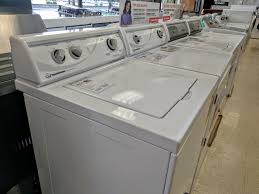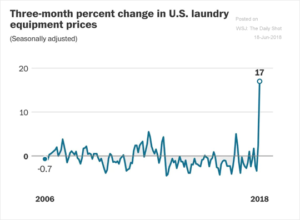
Photo: wikipedia.org
When the GOP Administration decided to protect the US appliance industry by awarding tariffs of 20 % on imported washers and dryers we predicted that the price of washers and dryers would rise. These appliances are basic to every household, with price rises hurting workers the most as they have seen their wages stagnant since the last recession. The three-month price increased for washing machines and dryers by 17 %. Ouuucch.

Sources: The Wall Street Journal, The Daily Shot – 6/18/18
From our blog on January 24 of this year:
“with a 20 % penalty on the first 1.2 million machines imported and a 50 % rate for any imports above that level. A 50 % tariff was awarded on all washing machine parts imported – all penalties are for a three year period. The administration is protecting Whirlpools’ market share of 43 %. LG responded by announcing price increases up to $50 per machine or more.”
Since January, Whirlpool responded to LG price increases raising their prices as well. We observed then too:
“These tariff actions will hurt consumers by first raising prices on imported machines then Whirlpool will raise prices by virtue of increased market strength with competitors losing share.”
So, what happened, prices have zoomed up by 17 % on all laundry appliances. The highest prices since 2006, actually durable goods prices have been good news on the inflation front declining over the past 10 years since the recession.
Consumer Reports notes that both LG and Samsung are starting up plants in the US to build washers and dryers, with possible volumes to move shipments below the 1.2 million volume level where the tariff kicks in. It remains to be seen how Whirlpool and the industry responds to prices on US built machines or will just keep prices high as long as the tariffs are in place.
Next Steps:
The Administration has had its time to perform an economic experiment on the American consumer, maybe it worked forcing Samsung and LG to startup plants in the US. However, it may just act as a catalyst for all manufacturers to keep prices high while the tariffs are in place. It’s time to examine in depth, understanding why US manufacturers are concerned about imports to answer the question if Whirlpool has 43 % market share why is it doing poorly? Economic analysis is required by experts, not shoot from the hip policies to satisfy a minority political segment that will actually get hurt hardest when the layoffs in the Midwest start happening as sales fall. The basic economic principle is that when prices rise demand falls – eventually. This administration can’t defy this principle all it tries. Let’s understand what is really happening and develop a win-win plan for consumers, manufacturers and importers.
